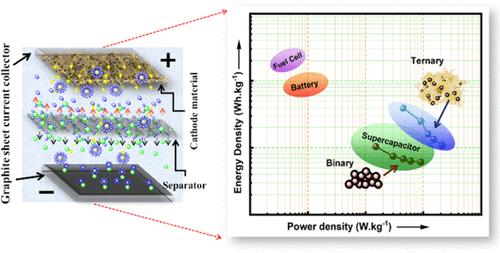增强 gC3N4@TiO2-x/MoS2 三元纳米复合材料的电化学储能性能
IF 8.3
2区 材料科学
Q1 MATERIALS SCIENCE, MULTIDISCIPLINARY
引用次数: 0
摘要
在此,我们采用两步水热法和溶剂回流法制备了 g-C3N4 添加缺陷诱导的 TiO2-x/MoS2 三元纳米复合材料。通过不同的结构、形态和成分特性测量技术,对氧空位并入的 TiO2-x、其二元 TiO2-x-MoS2 和三元 gC3N4@TiO2-x-MoS2 纳米复合材料进行了评估。此外,还通过在三电极和两电极系统中制造超级电容器测量了电化学电荷存储性能。在电流密度为 0.5 mA-cm-2 时,30 wt % g-C3N4(在 20、30 和 40% gC3N4 中)基 TiO2-x/MoS2 显示出 1351.47 mF-cm-2 的极高比面积电容。在电流密度为 4 mA-cm-2 的条件下,经过 5000 次循环后,电容保持率达到 90%。此外,还制造出一种非对称超级电容器(ASC),其体积能量密度高达 784.31 mWh-cm-3,功率密度为 9 W-cm-3,循环 5000 次后容量保持率高达 95%。由此证明,这种三元纳米复合电极具有显著的电容潜力和更强的循环稳定性。本文章由计算机程序翻译,如有差异,请以英文原文为准。

Enhanced Electrochemical Energy Storing Performance of gC3N4@TiO2-x/MoS2 Ternary Nanocomposite
Herein, we delineate the preparation of a g-C3N4-added defect-induced TiO2-x/MoS2 ternary nanocomposite using a two-step hydrothermal method followed by a solvent-reflux process. The oxygen vacancy-incorporated TiO2-x, its binary TiO2-x-MoS2, and ternary gC3N4@TiO2-x-MoS2 nanocomposites are evaluated by different structural, morphological, and compositional property measurement techniques. Further, the electrochemical charge-storage performance is measured by fabricating a supercapacitor in a three-electrode as well as a two-electrode system. The 30 wt % g-C3N4 (among 20, 30, and 40% gC3N4)-based TiO2-x/MoS2 shows a very high specific areal capacitance of 1351.47 mF·cm–2 at a current density of 0.5 mA·cm–2. An extraordinary cycling stability with 90% capacity retention after 5000 cycles at a current density of 4 mA·cm–2 is achieved. Moreover, an asymmetric supercapacitor (ASC) is fabricated, obtaining an outstanding volumetric energy density of 784.31 mWh·cm–3 and a power density of 9 W·cm–3 with an extraordinary capacity retention of up to 95% after 5000 cycles. Thus, it is demonstrated that the ternary nanocomposite electrode has an outstanding potential to exhibit remarkable capacitance with enhanced cyclic stability.
求助全文
通过发布文献求助,成功后即可免费获取论文全文。
去求助
来源期刊

ACS Applied Materials & Interfaces
工程技术-材料科学:综合
CiteScore
16.00
自引率
6.30%
发文量
4978
审稿时长
1.8 months
期刊介绍:
ACS Applied Materials & Interfaces is a leading interdisciplinary journal that brings together chemists, engineers, physicists, and biologists to explore the development and utilization of newly-discovered materials and interfacial processes for specific applications. Our journal has experienced remarkable growth since its establishment in 2009, both in terms of the number of articles published and the impact of the research showcased. We are proud to foster a truly global community, with the majority of published articles originating from outside the United States, reflecting the rapid growth of applied research worldwide.
 求助内容:
求助内容: 应助结果提醒方式:
应助结果提醒方式:


